Part IV…Where the Pavement Ends
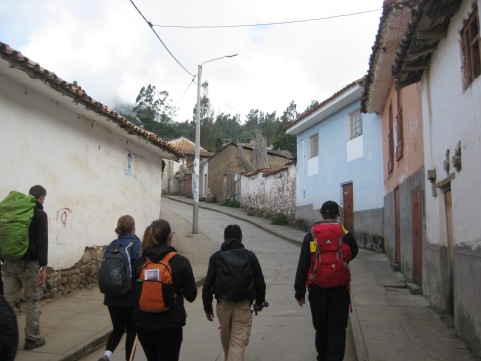
At about 3 am we found ourselves in the hotel lobby, waiting to catch a bus in the predawn darkness bound for the remote Peruvian village of Mollepata, the traditional starting off point of the Salkantay trail.
At the time, I was not aware (maybe Sylvia was, but if so, she didn’t tell me) that all Peruvian guided adventures begin in the very early hours of the morning, behind schedule, with surly drivers of crowded, dirty vehicles honking horns and cursing western tourists in Spanish and Quechua; after which there is a period of furious, breakneck driving down impossibly windy mountain roads, until finally we reach our destination where everyone stands around for a good two or three hours while nothing happens. And then we have breakfast.
Having been on a few of these adventures now, I understand the drill, but at the time it was quite astonishing. When the bus showed up we where hastily ushered in and driven to a certain location where we were taken out again and rushed unceremoniously into another car, this one more of a mini-van, smelling badly of mold. We took our seat beside a couple of young tourist girls who greeted us with smiles. We said something, they said something back; neither of us understood the other.
At length the van pulled into a fuel station where we gassed up and noxious, foul smelling fumes poured into the already smelly interior of the vehicle. Then on to another stop, where the door was opened and a large bag of biscuits, perhaps the size of a man, was hurled in on top of me. The door closed, and the van moved on.
What followed was probably the most spectacular car ride of my life, but I was too busy desperately trying not vomit to really notice. Just after sunrise we turned off the main highway and up onto a dirt highway ascending through the steep jungled hillside; no Bolivian Death Highway could hold a candle to this alleged road, which appeared at times to have been bulldozed from the mud that very morning. Six or seven hundred feet below, a roiling river rushed through an impossibly deep gorge. Was it the Urubamba I was seeing? I have no idea, by then I was too sick to care and had utterly lost my bearings.
Three or so weary hours after we began, we pulled into fog-bound Mollepata, at nearly ten thousand feet in the Andean high jungle. The paved road literally begins on one side of this town, goes for perhaps five blocks and ends at the other side; the rest is tracks through mud generously called roads. Where the pavement ends, our adventure began.

Time to pile out of the van, stand around and wait for breakfast. In a crude barn-like structure the various hiking guides gathered the groups together. A crowing rooster stationed just outside the door reminded us every minute or so that it was in fact morning, time to get going. We sat down beside a pair of young travelers who identified themselves as German, and as usual, spoke more of my language than I spoke theirs. My appetite quickly recovered as breakfast was served.
The guides split us up into groups by some logic which was not apparent to me then or now. We were in the second group, which actually ended up being the fitter and faster of the two groups (not because of myself.) In the village plaza we introduced ourselves; Sylvia and I, two Germans, one Frenchman, a Brazilian, a pair of Argentinian girls, a French Canadian, and a Peruvian man who would turn out to be a Doctor, and his daughter. The trip was in fact her fifteenth birthday present, we were told. Everyone was younger than us by the better part of two decades, except the doctor…who was from Huancayo, a city itself located at 10,000 feet, and thus he was perhaps best acclimated. I, the lone Gringo and native English speaker, would be a severe disadvantage in many ways.
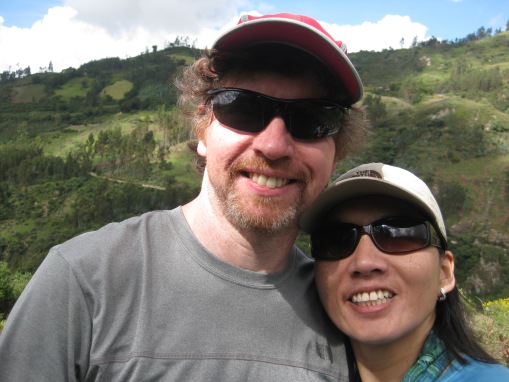
We set off following our guide, whose name was Willie (Guillermo). The first few miles were over muddy, rutted roads through sparsely populated farmland. Cars or small trucks would sometimes pass; sometimes, men on the backs of donkeys. Below us, thousands of feet, was a cloud obscured valley lined by verdant, terraced hillsides. It reminded me of pictures of Southeast Asia. At one point a rainbow arced over the view; it was the first time I had seen a rainbow that big from above.
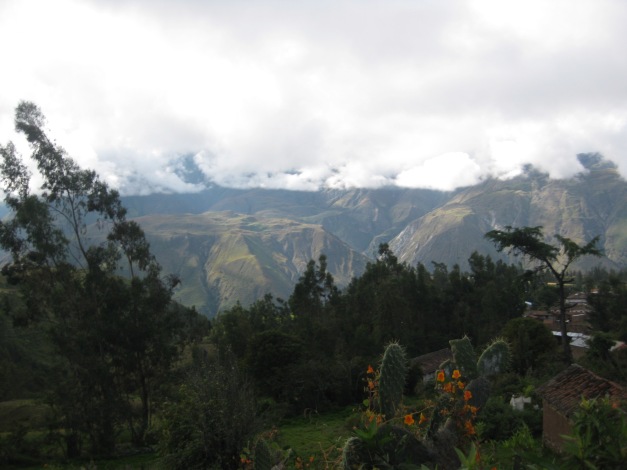

The walking was easy and our loads not especially heavy, but we had a lot of miles to cover (the first day’s distance was 25 kilometers.) Because we had a long way to go, the guides kept up a brisk pace and continually had us taking shortcuts…small, muddy paths that cut across the switchbacks in the road. Here, the elevation several times got the best of me. When short of breath, my tendency was to breathe faster and push on. Which turned out to be exactly the wrong thing to do…when the air is thin, you can breathe as hard and fast as you like, but the oxygen just isn’t there. You must stop and wait for the heart to stop racing and the head to cease swimming. But this is a lesson I would learn the hard way.
At our lunch stop, we received an unexpected boon…the guides offered to transport up to five kilos of gear on the pack horse that was carrying the groups equipment, per person. This, for the metric illiterate, is about eight pounds. And this, for the hiking illiterate, is the best news EVER. Eight pounds off my back! For the hardcore hikers out there, I know you are going to say its cheating but…hey, it ain’t cheatin’, it’s making use of OUR bleeping hired horse. At any rate, gear was taken out of the pack and went to the horse (of course, of course) and I felt so much lighter.

And it was a good thing…the path began to angle steadily upward, never steep but as it gained altitude my head started to feel…less clear. And Sylvia and I began to fall further and further behind the rest of the group. Ahead, ominous looking snow-capped peaks appeared from behind curtains of gray clouds, while all around us the landscape transformed from lush jungle to bleak high scrub. We had come to the high country.
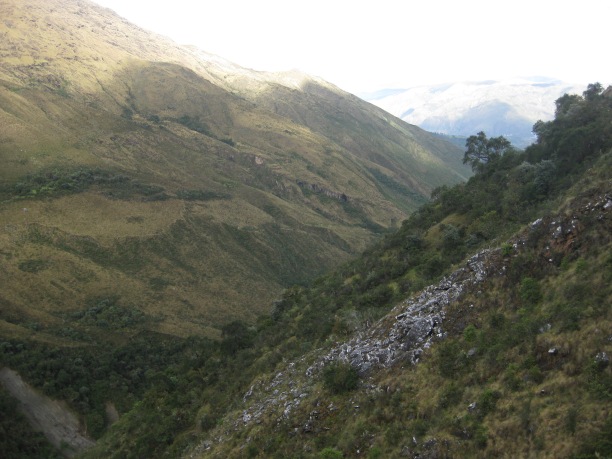
I began to sicken…suddenly I was chilled, and seeing double. I donned all my layers and went to zip up my jacket…hard to do when you see two sets of zippers. Oddly at this moment, a squad of fast moving, unencumbered hikers zipped merrily by, bells tied to their hiking poles jangling. They were headed for a high priced high lodge with spacious accommodations. Meanwhile, I could barely stand.
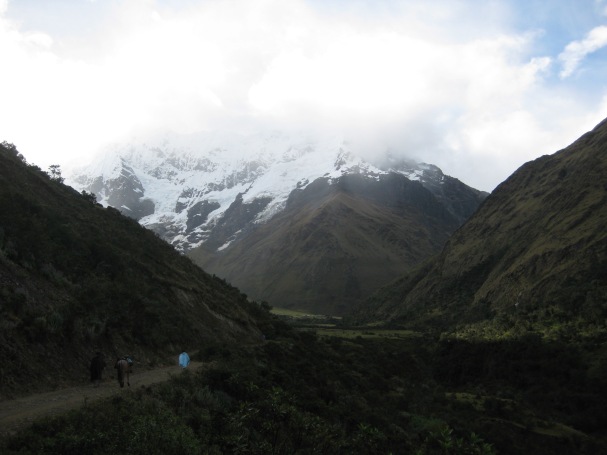
I blundered forward after Sylvia, nauseous and dizzy. Step by step by hard step. I stumbled through a rocky area, where finally I bent over and retched forth lunch. Looking up I saw three locals unloading a pickup truck, ignoring me. Beyond this, atop a low rise, a large pavilion had been set up. I stumbled towards it, passing milling sheep, cows and tourists. And there to great us was Willie the guide…I had reached our nights destination, alive.
But not in good shape. Our ‘hotel’ was basically a vast billowing tent, inside which were smaller tents. We crawled into ours, me shivering, and I immediately went to sleep. Soon, a guide stopped by with a cup of coca leaf tea for each of us. Coca, the active ingredient in cocaine, helps mollify the symptoms of AMS (acute mountain sickness) which I was certainly suffering from. In an hour or so I was well enough to rise and get some dinner, but I was openly speculating on whether I could handle what lay ahead. We had done a hard day’s hike, and were camped at nearly 12,000 feet, but tomorrow we had to go another 20 or so kilometers, and cross the high point of the entire trip…the pass of Salkantay, more than a thousand meters above where we were now. If I had struggled today, what would tomorrow bring? I decided to rest on the question. After dinner I retired to my sleeping bag, and, listening to the wind, the howls of wild dogs, and the periodic barfing of European trekkers, fell into an uneasy sleep.

Next: Part V…The Savage Mountain